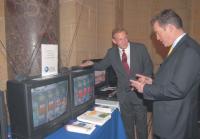
Serving the Vermont Champlain Valley Area for 45 Years
Main SectionsFront Page SportsValley VitalsIt's in the StarsStarwiseArchivesLinksAbout The VoiceContact Us |
Switch To Digital Television In The Works, And Consumers Need To Get Prepared NowTuesday February 5, 2008 By Ed Barna You may have noticed press reports saying there was a big federal auction of airwave space on Jan. 24 that should improve some kinds of wireless service. If you saw that story on Channel 3 or Channel 5, which came in because of a rooftop antenna or “rabbit ears” indoor antenna, look more closely. The frequencies on which Channel 3 and 5 have been broadcasting for decades, along with other similar channels, are owned now by non-TV companies. In other words, in plain English, kiss your old TV goodbye-UNLESS you have an electronic device that converts analog signals to digital. As of Feb. 17, 2009, the Digital Television Transition and Public Safety Act of 2005 mandates that all television signals be transmitted digitally. But it’s not that revol-utionary a change, because cable and satellite TV are doing it already. What are “analog” and “digital”? Without going into very complicated explanations: vinyl LP 33rpm records are analog; CD compact discs are digital. Cameras that record pictures on film are analog; those that record them on computer chips are digital. Composing newspaper pages by putting hunks of type into rows was analog; using word-processing and page layout is digital. The original may have been using letters to represent the sounds of words in sentences rather than using sign language You see the pattern. There’s been a steady shift to coded information about things rather than signals analogous to the original information, and now it’s TV’s turn—because the new electronically processed formats are more powerful and flexible and save lots of space. Before going on to the nifty future, let’s stay with the converter box problem, for the sake of the many Vermonters who can’t afford cable or satellite and might get lost in this high-tech transition. If you bought your TV after Jan. 1 of this year, you don’t have to worry. The related laws say all new TV’s have to be digitally capable (but check your manual to be sure—and always save your receipts). If you can afford to buy a converter, no problem. No source for this article said they will cost any more than $70. But if you would have trouble with that price, HERE’S THE MAIN POINT OF THIS ARTICLE. YOU SHOULD SEND IN FOR A $40 FEDERAL REBATE COUPON RIGHT NOW, OR FOR TWO COUPONS IF YOU WILL NEED THEM. To request one or two coupons, go to www.dtv2009.gov The background to this is, Congress knew some people might get hurt by the switch to digital, so they budgeted $990 million for 22.5 million coupons, and added the possibility of authorizing another $510 million for another 11.25 million coupons. And it’s an election year, so the supply of coupons might not run out—but it’s also a time when tax revenues are running short, so why take the chance? You won’t get the coupon(s) right away, but that’s actually a good thing—agency foresight, not bureaucratic slowness. The feds are still going through the process of approving different manufacturers’ converter boxes, which aren’t supposed to be available until late February of early March, and once a coupon is issued, it has to be used within 90 days. The General Accounting Office issued a report last November criticizing the National Telecommunications and Information Administration (NTIA), which had pretty much left the whole thing to the private sector. “GAO found no comprehensive plan or strategy to measure progress and results. Such planning includes managing and mitigating risks, which can help organizations identify potential problems before they occur and target limited resources.” But the private sector has been preparing. To cite one company represented in Addison County, Radio Shack said in Rutland that they should have certified converters for sale in three weeks (less by the time you read this). Best Buy and Circuit City also said they were determined to avoid problems. ABC, CBS and Fox sources in Vermont all said they have digital versions of their analog channels going, plus “multicasting” channels within their digital bands that do public service things like give weather information. Repair services in Rutland said they were geared up as well. By the time everything is sorted out, the federal government should All digital is said to be better than analog, and high-definition digital was described by one source as “scary” in its lifelike appearance. It’s not that seeing the blades of grass on the football stadium and the imperfections on program hosts’ faces would be scary, he said. He’s afraid that with the nation already bogged down in the unreal world, cruising toward an obesity epidemic on their couches with remote in hand, HDTV will lead too many more people to lead unhealthy and unimaginative virtual lives.
|
AdvertisementsSearch our Archives |
Agricultural Weather Forecast:

© 2006-18 The Valley Voice • 656 Exchange St., Middlebury, VT 05753 • 802-388-6366 • 802-388-6368 (fax)
Valleywides: [email protected] • Classifieds: [email protected] • Info: [email protected]

 Printer Friendly
Printer Friendly